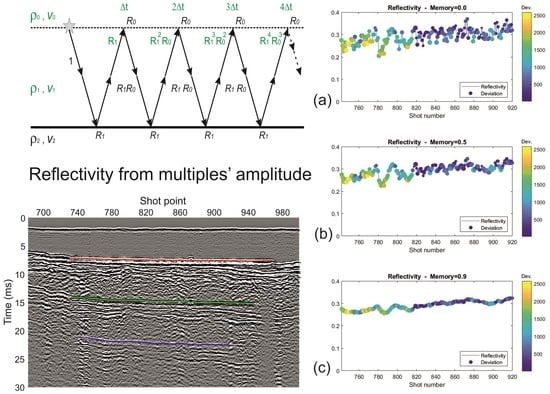Sea Floor Characterization by Multiples’ Amplitudes in Monochannel Surveys
Abstract
:1. Introduction
2. Materials and Methods
2.1. Amplitude of Multiple Reflections
2.2. Spherical Divergence Correction
2.3. Reflectivity Robustness by Physical Constraints
3. Results
3.1. Application to a Synthetic Survey
3.2. Application to a Real Marine Survey
4. Discussion and Conclusions
Author Contributions
Funding
Institutional Review Board Statement
Informed Consent Statement
Data Availability Statement
Acknowledgments
Conflicts of Interest
References
- Alkhalifah, T.A. Full Waveform Inversion in an Anisotropic World; Education Tour Series; EAGE: Houten, The Netherlands, 2014; 197p, ISBN 9789462822023. [Google Scholar]
- Owusu, J.C.; Podgornova, O.; Charara, M.; Leaney, S.; Campbell, A.; Ali, S.; Borodin, I.; Nutt, L.; Menkiti, H. Anisotropic elastic full-waveform inversion of walkaway vertical seismic profiling data from the Arabian Gulf. Geophys. Prospect. 2016, 64, 38–53. [Google Scholar] [CrossRef]
- Huang, X.; Solberg Eikrem, K.; Jakobsen, M.; Nævdal, G. Bayesian full-waveform inversion in anisotropic elastic media using the iterated extended Kalman filter. Geophysics 2020, 85, C125–C139. [Google Scholar] [CrossRef]
- Askan, A.; Akcelik, V.; Bielak, J.; Ghattas, O. Full waveform inversion for seismic velocity and anelastic losses in heterogeneous structures. Bull. Seismol. Soc. Am. 2007, 97, 1990–2008. [Google Scholar] [CrossRef]
- Komatitsch, D.; Xie, Z.; Bozdağ, E.; Sales de Andrade, E.; Peter, D.; Liu, Q.; Tromp, J. Anelastic sensitivity kernels with parsimonious storage for adjoint tomography and full waveform inversion. Geophys. J. Int. 2016, 206, 1467–1478. [Google Scholar] [CrossRef]
- Vesnaver, A.; Lin, R. Broadband Q-factor tomography for reservoir monitoring. J. Appl. Geophys. 2019, 165, 1–15. [Google Scholar] [CrossRef]
- Maurenbrecher, P.M.; Wever, T. H-Sense’: Harbour sediment mapping using Chirp reflection surveys in Norway and Sweden. Expanded Abstract. In Proceedings of the 4th EEGS Meeting, Barcelona, Spain, 14–17 September 1998. cp-43-00065. [Google Scholar] [CrossRef]
- Barsottelli-Botelho, M.A.; Mesquita, L. Using GPR and high frequency seismic to locate under water buried pipes. Extended Abstracts. In Proceedings of the Near Surface Geoscience Conference, Turin, Italy, 6–10 September 2015. We21P104. [Google Scholar] [CrossRef]
- Richardson, W.J.; Greene, C.R.; Malme, C.I.; Thomson, D.H. Marine Mammals and Noise; Academic Press: San Diego, CA, USA, 1998; ISBN 9780080573038. [Google Scholar]
- Gordon, J.; Gillespie, D.; Potter, J.; Frantzis, A.; Simmonds, M.P.; Swift, R.; Thompson, D. A review of the effects of seismic surveys on marine mammals. Mar. Technol. Soc. J. 2003, 37, 16–34. [Google Scholar] [CrossRef]
- Baradello, L.; Carcione, J.M. Optimal seismic-data acquisition in very shallow waters: Surveys in the Venice lagoon. Geophysics 2008, 73, Q59–Q63. [Google Scholar] [CrossRef]
- Tosi, L.; Rizzetto, F.; Zecchin, M.; Brancolini, G.; Baradello, L. Morphostratigraphic framework of the Venice Lagoon (Italy) by very shallow water VHRS surveys: Evidence of radical changes triggered by human-induced river diversions. Geophys. Res. Lett. 2009, 36, 1–5. [Google Scholar] [CrossRef]
- Quinn, R.; Bull, J.M.; Dix, J.K. Imaging wooden artefacts using Chirp sources. Archaeol. Prospect. 1997, 4, 25–35. [Google Scholar] [CrossRef]
- Quinn, R.; Bull, J.M.; Dix, J.K. Optimal processing of marine high resolution seismic reflection (Chirp) data. Mar. Geophys. Res. 1998, 20, 13–20. [Google Scholar] [CrossRef]
- Plets, R.M.K.; Dix, J.K.; Best, A.I. Mapping of the buried Yarmouth roads wreck, isle of Wight, UK, using a Chirp sub-bottom profiler. Int. J. Naut. Archaeol. 2008, 37, 360–373. [Google Scholar] [CrossRef]
- Kim, Y.J.; Koo, N.H.; Cheong, S.H.; Kim, J.K.; Seo, K.S.; Hwang, K.D.; Kim, C.S.; Lee, H.Y.; Kim, W.S. A case study of 3D Chirp sub-bottom profiles survey at ancient wooden shipwreck site in Korea. Expanded Abstracts. In Proceedings of the Near Surface Geoscience Conference, Barcelona, Spain, 4–8 September 2016; pp. 1–5. [Google Scholar] [CrossRef]
- Gutowski, M.; Bull, J.; Henstock, T.; Dix, J.K.; Hogarth, P.; Leighton, T.; White, P. Chirp sub-bottom profiler source signature design and field testing. Mar. Geophys. Res. 2002, 23, 481–492. [Google Scholar] [CrossRef]
- Müller, C.; Milkereit, B.; Bohlen, T.; Theilen, F. Towards high-resolution 3D marine seismic surveying using Boomer sources. Geophys. Prospect. 2002, 50, 517–526. [Google Scholar] [CrossRef]
- Müller, C.; Woelz, S.; Ersoy, Y.; Boyce, J.; Jokisch, T.; Wendt, G.; Rabbel, W. Ultra-high-resolution 2D-3D seismic investigation of the Liman Tepe/Karantina Island archeological site (Urla/Turkey). J. Appl. Geophys. 2009, 68, 124–134. [Google Scholar] [CrossRef]
- Vardy, M.E. Deriving shallow-water sediment properties using post-stack acoustic impedance inversion. Near Surf. Geophys. 2015, 13, 143–154. [Google Scholar] [CrossRef]
- Schock, S.G.; LeBlanc, L.R.; Mayer, L.A. Chirp sub-bottom profiler for quantitative sediments analysis. Geophysics 1989, 54, 445–450. [Google Scholar] [CrossRef]
- Baradello, L. An improved processing sequence for uncorrelated Chirp sonar data. Mar. Geophys. Res. 2014, 35, 337–344. [Google Scholar] [CrossRef]
- Vardy, M.E. Remote characterization of shallow marine sediments—Current status and future questions. Extended Abstracts. In Proceedings of the Near Surface Geoscience Conference, Barcelona, Spain, 4–8 September 2016. MoASM05. [Google Scholar] [CrossRef]
- Faggetter, M.; Vardy, M.; Dix, J.; Bull, J.; Henstock, T. Time-lapse imaging of the shallow subsurface at decimetre scale resolution. Extended Abstracts. In Proceedings of the EAGE Annual Meeting, London, UK, 3–6 June 2019. WS02_11. [Google Scholar] [CrossRef]
- Boldreel, L.O.; Grøn, O.; Cvikel, D. Synthetic 3D Recording of a shipwreck embedded in seafloor sediments: Distinguishing internal details. Heritage 2021, 4, 541–553. [Google Scholar] [CrossRef]
- Kim, S.B.; Park, H.L. Optimizing source wavelets extracted from the Chirp sub-bottom profiler using an adaptive filter with machine learning. J. Mar. Sci. Eng. 2022, 10, 449. [Google Scholar] [CrossRef]
- Mackenzie, K.V. Nine-term equation for sound speed in the oceans. J. Acoust. Soc. Am. 1981, 70, 807–812. [Google Scholar] [CrossRef]
- Vesnaver, A.; Baradello, L. Shallow velocity estimation by multiples for monochannel Boomer surveys. Appl. Sci. 2022, 12, 3046. [Google Scholar] [CrossRef]
- Vesnaver, A.; Baradello, L. Tomographic joint inversion of direct arrivals, primaries and multiples for monochannel marine surveys. Geosciences 2022, 12, 219. [Google Scholar] [CrossRef]
- Schwardt, M.; Wilken, D.; Rabbel, W. Attenuation of seismic multiples in very shallow water: An application in archaeological prospection using data driven approaches. Remote Sens. 2021, 13, 1871. [Google Scholar] [CrossRef]
- Constable, S.C.; Parker, R.L.; Constable, C.G. Occam’s inversion: A practical algorithm for generating smooth models from electromagnetic sounding data. Geophysics 1987, 52, 289–300. [Google Scholar] [CrossRef]
- Claerbout, J. Imaging the Earth’s Interior; Blackwell: Oxford, UK, 1985; pp. 233–234. [Google Scholar]
- Denich, E.; Vesnaver, A.; Baradello, L. Amplitude recovery and deconvolution of Chirp and Boomer data for marine geology and offshore engineering. Energies 2021, 14, 5704. [Google Scholar] [CrossRef]
- Francois, R.E.; Garrison, G.R. Sound absorption based on ocean measurements: Part I:Pure water and magnesium sulfate contributions. J. Acoust. Soc. Am. 1982, 72, 896–907. [Google Scholar] [CrossRef]
- Francois, R.E.; Garrison, G.R. Sound absorption based on ocean measurements: Part II:Boric acid contribution and equation for total absorption. J. Acoust. Soc. Am. 1982, 72, 1879–1890. [Google Scholar] [CrossRef]
- Ainslie, M.A.; McColm, J.G. A simplified formula for viscous and chemical absorption in sea water. J. Acoust. Soc. Am. 1998, 103, 1671–1672. [Google Scholar] [CrossRef]
- Romeo, R.; Baradello, L.; Blanos, R.; Congiatu, P.P.; Cotterle, D.; Ciriaco, S.; Donda, F.; Deponte, M.; Gazale, V.; Gordini, E.; et al. Shallow geophysics of the Asinara Island Marine Reserve Area (NW Sardinia, Italy). J. Maps 2019, 15, 759–772. [Google Scholar] [CrossRef]
- Andreucci, S.; Pascucci, V.; Clemmensen, L. Upper Pleistocene coastal deposits of West Sardinia: A record of sea-level and climate change. GeoActa 2006, 5, 79–96. [Google Scholar]

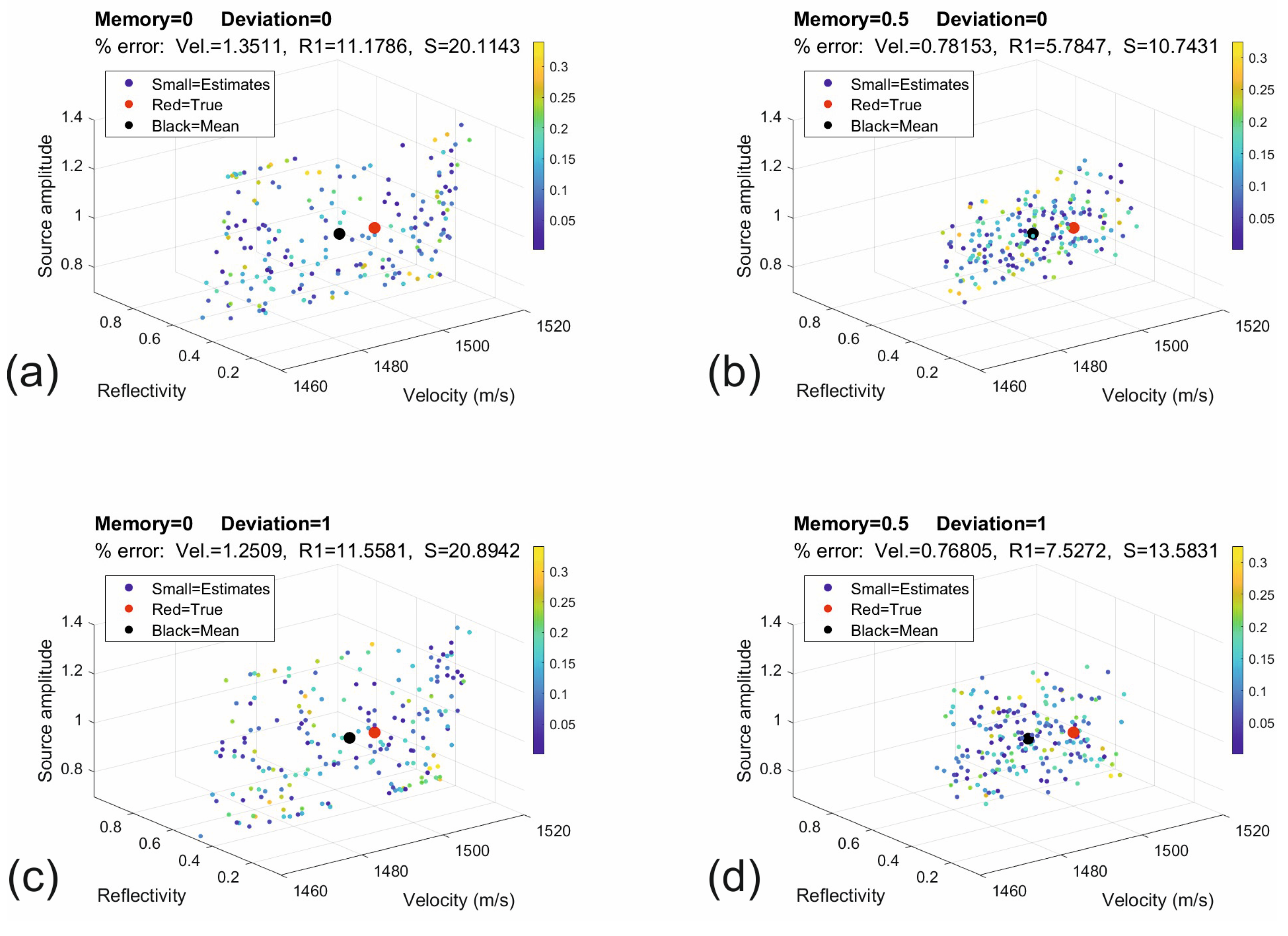
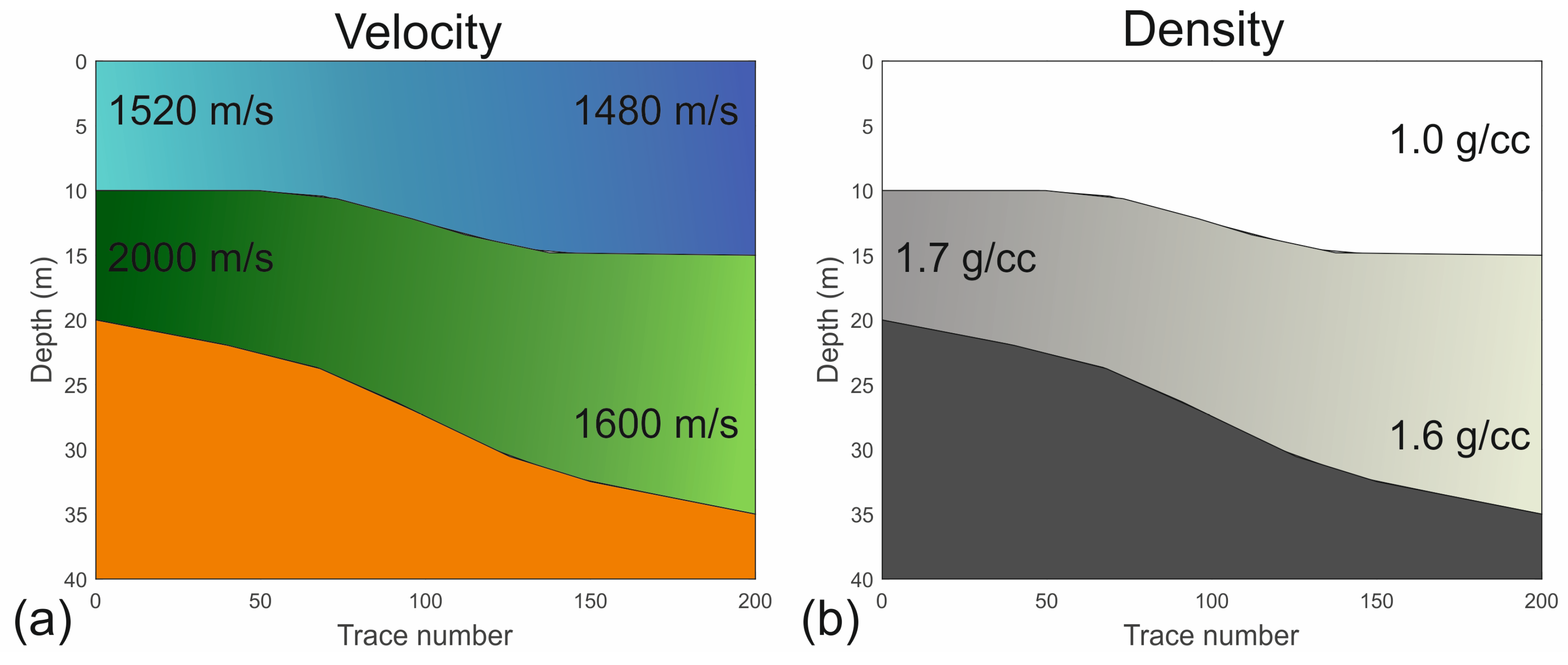
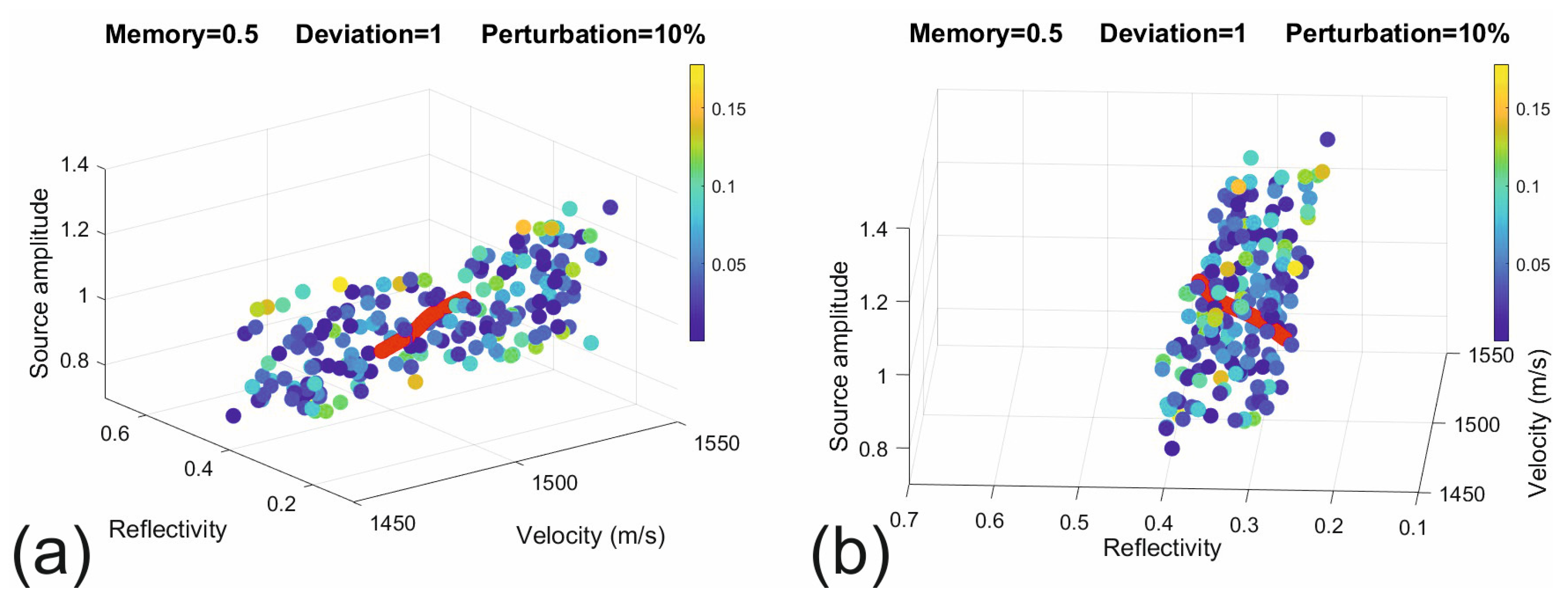
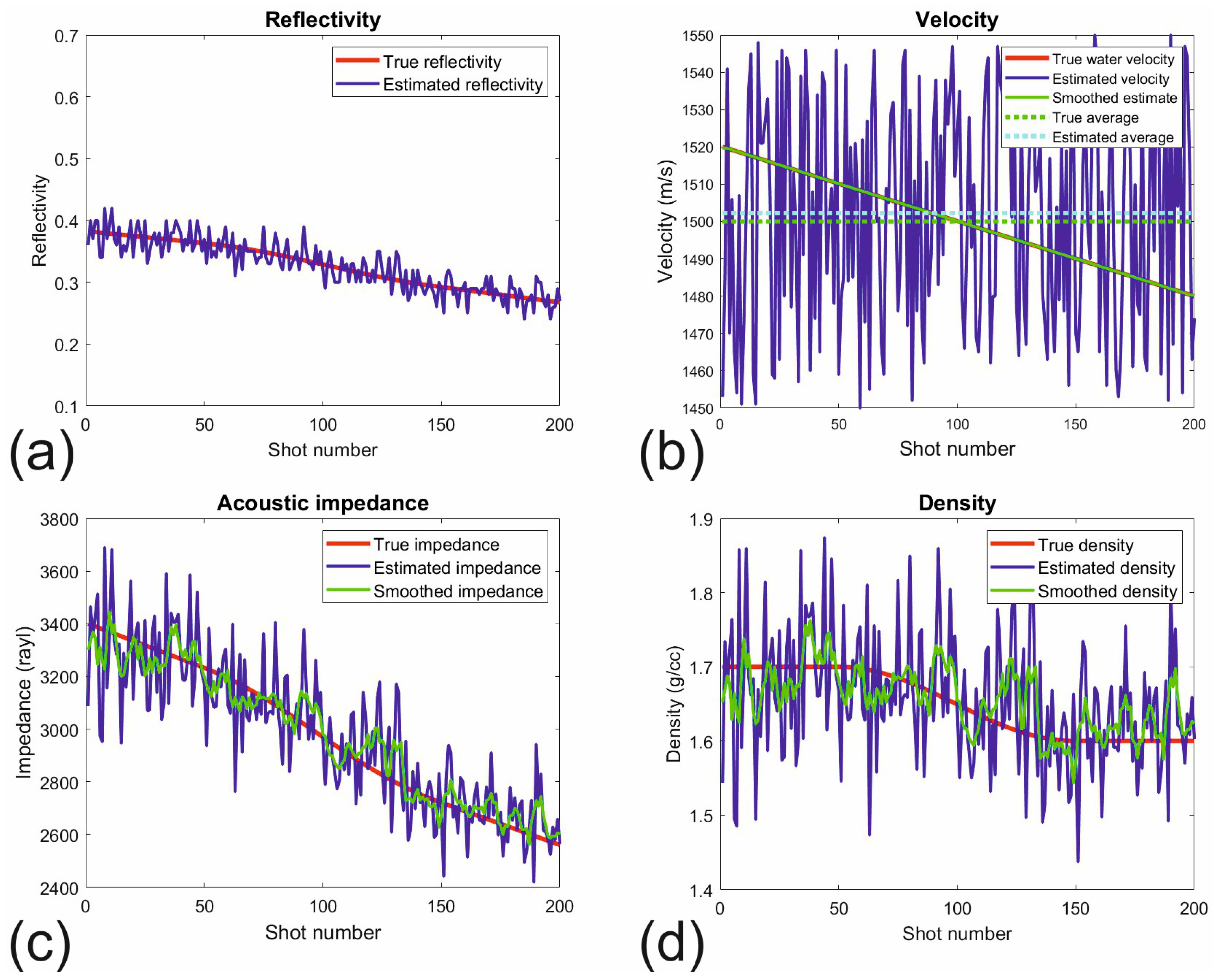

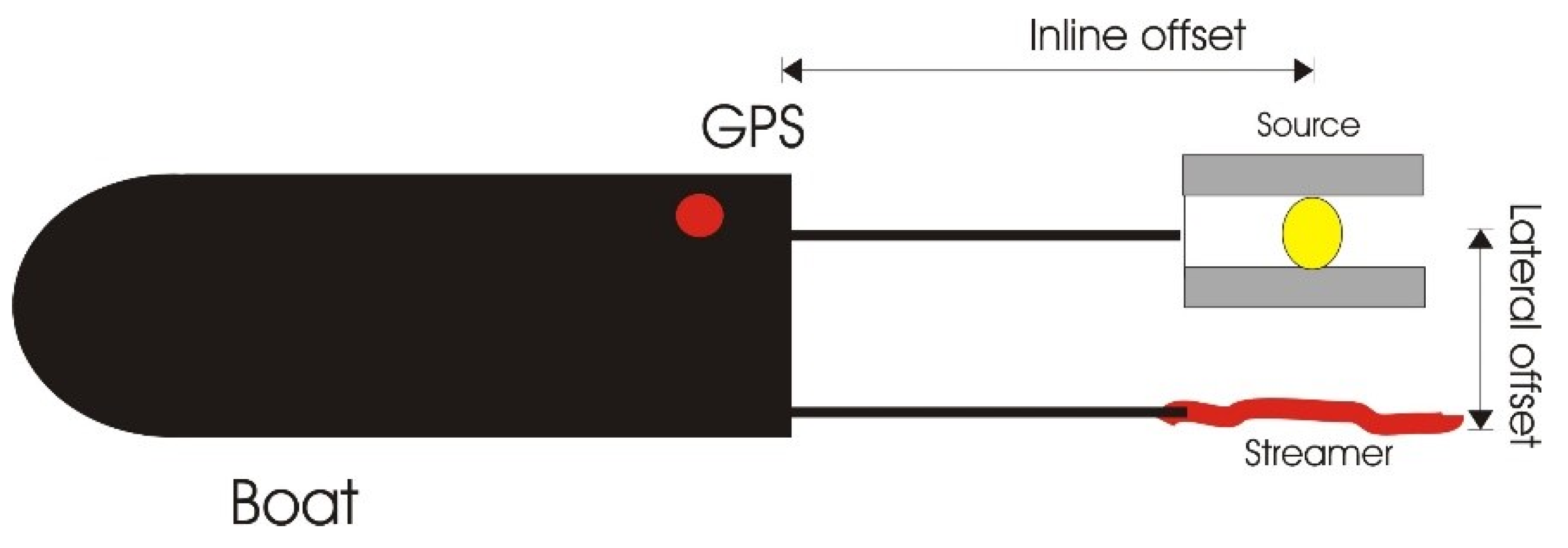
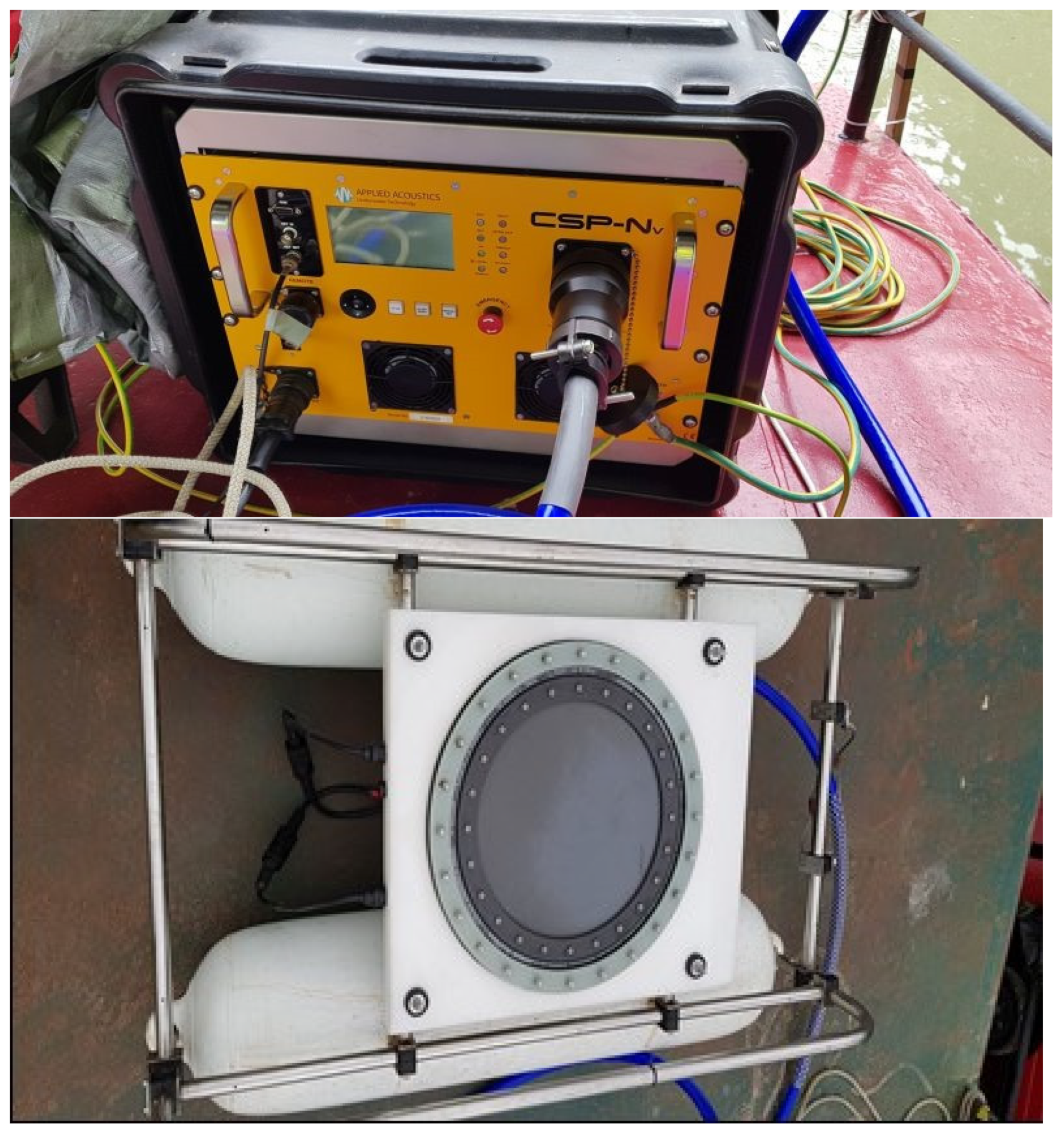
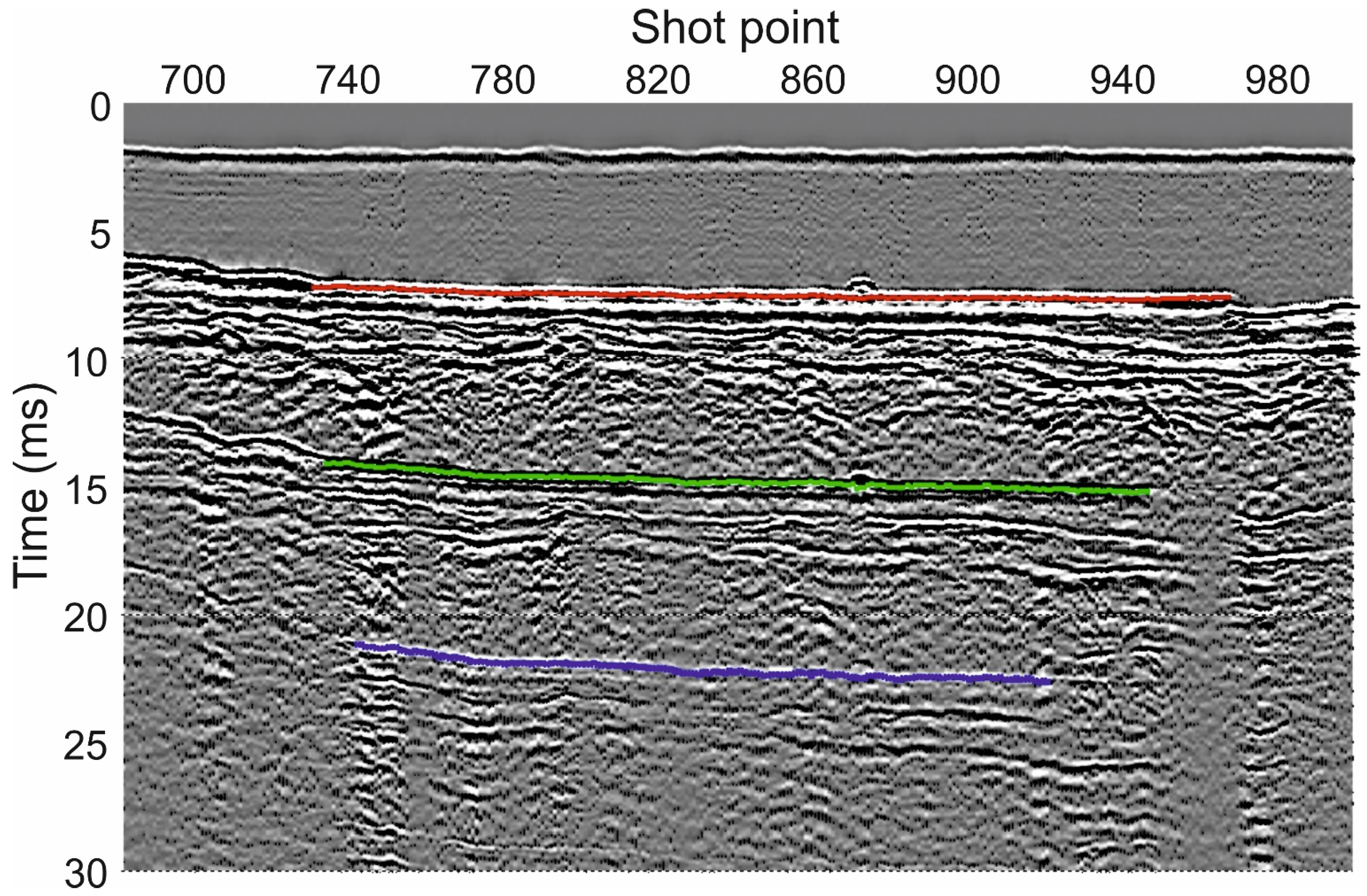


| Two-way time | 0 | ∆t | 2 ∆t | 3 ∆t | 4 ∆t |
| Amplitude | 1 | R1 | R12 R0 | R13 R02 | R14 R03 |
| Multiple order | 0 | 1 | 2 | 3 | 4 |
| Source type | Boomer, model AAE301 |
| Manufacturer | Applied Acoustics Engineering |
| Recording system | SB-logger |
| Frequency range | 0.4–6 kHz |
| In-line offset source-receiver | About 3 m |
| Lateral offset source-receiver | About 1 m |
| Navigation speed | 3.5–4 knots |
| Recorded shots | 300 |
| Shooting interval | 3 per second |
| Distance between shots | 0.6–0.7 m |
| Sampling interval | 50 microseconds |
| Recording duration | 200 milliseconds |
Disclaimer/Publisher’s Note: The statements, opinions and data contained in all publications are solely those of the individual author(s) and contributor(s) and not of MDPI and/or the editor(s). MDPI and/or the editor(s) disclaim responsibility for any injury to people or property resulting from any ideas, methods, instructions or products referred to in the content. |
© 2023 by the authors. Licensee MDPI, Basel, Switzerland. This article is an open access article distributed under the terms and conditions of the Creative Commons Attribution (CC BY) license (https://creativecommons.org/licenses/by/4.0/).
Share and Cite
Vesnaver, A.; Baradello, L. Sea Floor Characterization by Multiples’ Amplitudes in Monochannel Surveys. J. Mar. Sci. Eng. 2023, 11, 1662. https://doi.org/10.3390/jmse11091662
Vesnaver A, Baradello L. Sea Floor Characterization by Multiples’ Amplitudes in Monochannel Surveys. Journal of Marine Science and Engineering. 2023; 11(9):1662. https://doi.org/10.3390/jmse11091662
Chicago/Turabian StyleVesnaver, Aldo, and Luca Baradello. 2023. "Sea Floor Characterization by Multiples’ Amplitudes in Monochannel Surveys" Journal of Marine Science and Engineering 11, no. 9: 1662. https://doi.org/10.3390/jmse11091662





